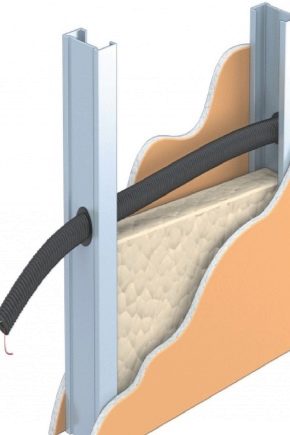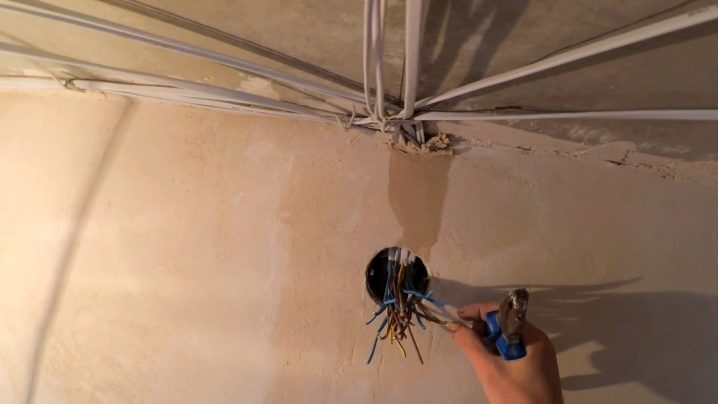Laying the cable in drywall: installation features

Drywall is appreciated by designers and amateur builders, who have found in it an excellent solution for hiding uneven walls. This material, in comparison with others, speeds up the restoration of the most complex premises many times over. In addition, it can be used to mask wiring, and without any strobes in the walls. Performing such manipulations can be dangerous if you do not take into account the specifics of the material and the key requirements for work.

Peculiarities
Plasterboard cable routing is a hidden type of wiring. For it can be used: pipes with a zero fire hazard, a corrugated hose, a box made of non-combustible material.
All these methods are provided for by the rules for the design of electrical installations, and if you follow the technical standards, you will get an electrical route that is reliably protected from mechanical and thermal influences. You can start work immediately after the profiles for gypsum plasterboards are mounted.
Each wire is supposed to be insulated and fixed in a special way - only then it will be possible to avoid emergencies.



Corrugated hose option
The clear advantage of this approach is the ease of replacing cables if they suddenly fail. The necessary components will be: the corrugated hose itself, clips that will hold it, distribution boxes, an electric cable, dowels-nails (clips are attached to them), a perforator and a drill to it.
Before the start of all work, it is imperative to assess how the devices that consume current are located in the room. Thinking over the configuration of the system, they also pay attention to the capacity of each of the target nodes. The diameter of the corrugation is selected according to the thickness of the cables to be installed. The next stage of work consists in attaching the corrugation to the wall, followed by closing it with profile frames.


To facilitate fastening, the wall is covered with holes, with a gap of 300-400 mm. It is at these points that it is convenient to pin the clips with dowel nails. During the installation process, you need to ensure that the cable does not sag anywhere. When marking the future power grid, first of all, the points where the distribution boxes, sockets and switches will stand are marked. When it is known that the ceiling will be closed, it is advisable to stretch the wiring from one box to another exactly there.
The wall wiring runs strictly 0.15-0.2 m below the ceiling, and distribution boxes are placed on the same line. These boxes themselves should be carefully selected - the cover must correspond to a certain level of protection, which is prescribed by the norms for branching electrical wiring in hollow walls.

Launching the cable into the corrugation starts from the boxesas clearly as possible maintaining the vertical towards each of the switches and lamps in the room. The same path should be applied when connecting the distributors to the outlets.
Experts recognize the VVGng series fireproof cable as the best option for laying in drywall. It is suitable even in a wooden house. It is also advisable to buy special socket boxes for drywall and terminal blocks that facilitate the docking of wires. It is recommended to use a drill with a 6.5 cm cutter - just such a format will allow you to reliably fit the socket outlets in the grooves.

Installation tips
You can replace the clips when installing the wiring with plastic clips.If you have the skill to handle them, work will go faster, but you need to be careful not to tear the corrugation with the edges of the profile. Holes of the required diameter are drilled in the profiles, but you can limit yourself to buying profiles with ready-made gaps. It is recommended to immediately remember where the end of the outgoing wire should be, since then the wall will be tightly sewn up with drywall.


If the repair has already been done
It so happens that after some time after installing the gypsum board sheets, there is a need to add sockets or switches under a layer of drywall.
This problem is completely solvable with your own hands, and even without dismantling the main layer, for this you need:
take a thread and a heavy nut;
prepare a round strobe in the selected place;
a thread is lowered from the open ceiling above the groove (the nut as a weight is lowered to the level of the hole);
the upper edge of the thread is used to connect the cable (insulating tape is used);
the thread is pulled down, bringing the conductor out, and the movement is stopped at this.

Installation of electrical channels
In most cases, the wires are made of copper, covering it from the outside with an insulating sheath. However, finishing the room with plasterboard requires the use of a metal frame and a large number of self-tapping screws with sharp edges. No insulation material will withstand contact with such products and will tear quickly. Therefore, in practice, the fastening of the corrugated reinforced shell channel has become the de facto standard.
Such tubes are very easy to install and allow you to further enhance protection against liquids and various rodents. As a result, there is no better way to provide power even in a private bathroom. PVC pipes or plastic channels are not so practical for installation - they are worse laid in hard-to-reach areas.

It is possible to fix cable ducts with frameless plasterboard cladding only after preliminary preparation of the necessary sections of the wall. They are grooved and a cable is laid in the grooves. To install the socket and the switch, it is imperative to cut special holes. Connect the cables to the walls with special clamps. This technology differs little from the creation of hidden wiring under a layer of plaster.
The electrical cable in the home network must be directed either vertically or horizontally, distortion of straight lines is not recommended. Vertical sections connect primarily the points of placement of switches and sockets, and horizontal sections are made next to ceilings and floors in order to maintain the required distance. When grooving, the work scheme is strictly followed. The depth is selected arbitrarily, only the complete immersion of the cable in the grooves is achieved.

For the installation of sockets, switches or junction boxes, round holes are prepared, reaching a depth of 35 mm. This work is done using drills and special nozzles (crowns), the diameter of which is strictly selected according to the width of the holes. When this preparation is over, you can mount the wiring under the gypsum board along the grooves. Putty is applied in the places where the cables are fastened. It is necessary to completely fill the grooves only after laying the entire circuit.


Woodwork
When gypsum plasterboards are mounted in a wooden house, the wiring technology is simplified many times over. The schematic diagram is the same as usual, but instead of a drill, it is worth using a cutter, which can successfully replace an electric tool. For fastening the corrugated hose, use plastic clamps or copper wire, making sure that the wiring cannot "walk" too freely. The more anchorage points (within reasonable limits), the more reliable the configuration.
You can use the same approaches when working with 380 V networks.


In the next video, you can clearly see how to lay the cable in a drywall wall.













The comment was sent successfully.